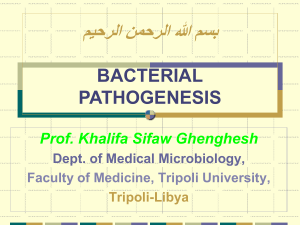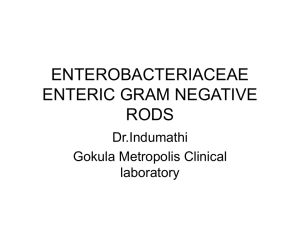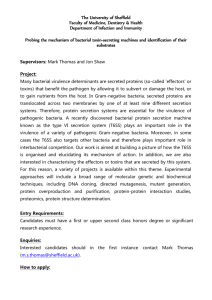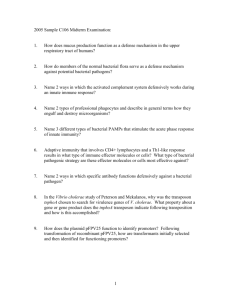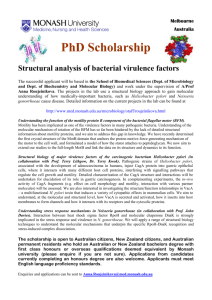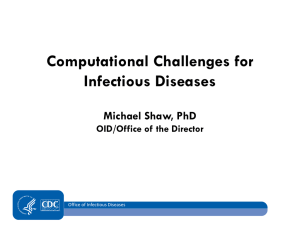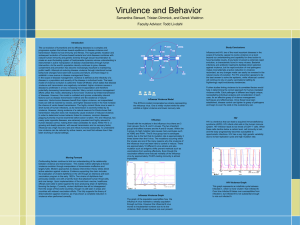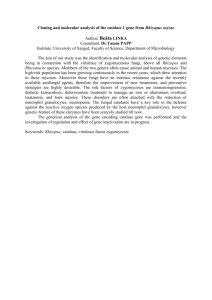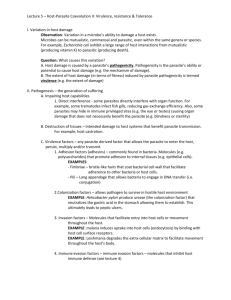Virulence evolution and the timing of disease life
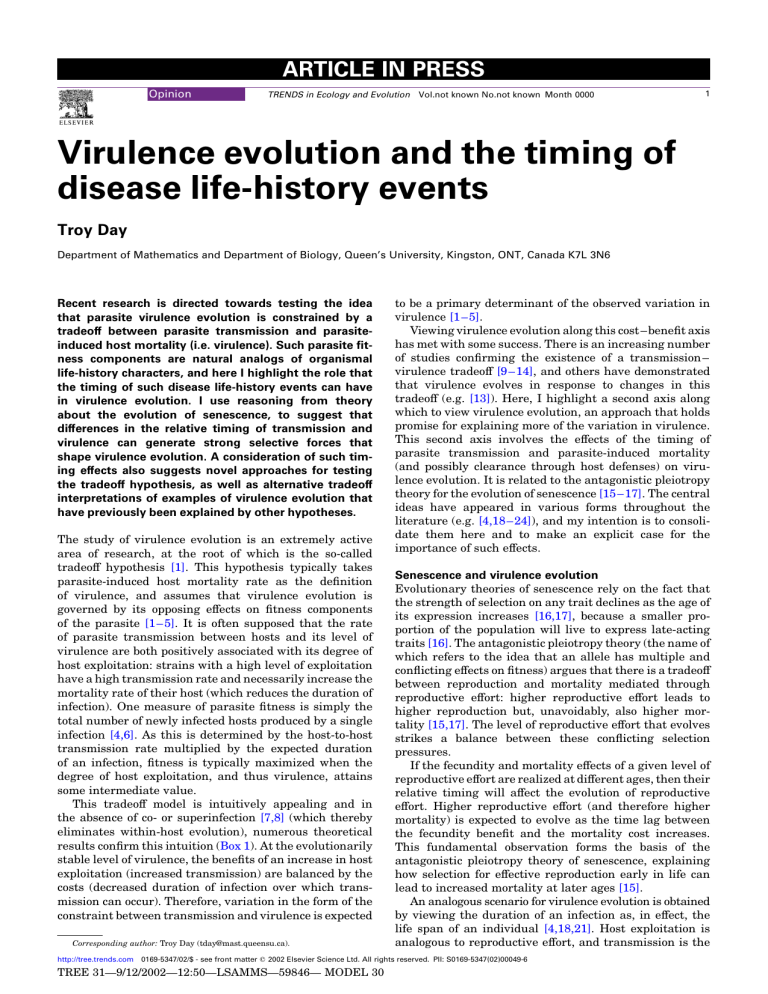
Opinion
ARTICLE IN PRESS
TRENDS in Ecology and Evolution Vol.not known No.not known Month 0000
Virulence evolution and the timing of disease life-history events
Troy Day
Department of Mathematics and Department of Biology, Queen’s University, Kingston, ONT, Canada K7L 3N6
Recent research is directed towards testing the idea that parasite virulence evolution is constrained by a tradeoff between parasite transmission and parasiteinduced host mortality (i.e. virulence). Such parasite fitness components are natural analogs of organismal life-history characters, and here I highlight the role that the timing of such disease life-history events can have in virulence evolution. I use reasoning from theory about the evolution of senescence, to suggest that differences in the relative timing of transmission and virulence can generate strong selective forces that shape virulence evolution. A consideration of such timing effects also suggests novel approaches for testing the tradeoff hypothesis, as well as alternative tradeoff interpretations of examples of virulence evolution that have previously been explained by other hypotheses.
to be a primary determinant of the observed variation in virulence
.
Viewing virulence evolution along this cost – benefit axis has met with some success. There is an increasing number of studies confirming the existence of a transmission – virulence tradeoff
[9 – 14] , and others have demonstrated
that virulence evolves in response to changes in this tradeoff (e.g.
[13] ). Here, I highlight a second axis along
which to view virulence evolution, an approach that holds promise for explaining more of the variation in virulence.
This second axis involves the effects of the timing of parasite transmission and parasite-induced mortality
(and possibly clearance through host defenses) on virulence evolution. It is related to the antagonistic pleiotropy theory for the evolution of senescence
ideas have appeared in various forms throughout the literature (e.g.
), and my intention is to consolidate them here and to make an explicit case for the importance of such effects.
The study of virulence evolution is an extremely active area of research, at the root of which is the so-called tradeoff hypothesis
[1] . This hypothesis typically takes
parasite-induced host mortality rate as the definition of virulence, and assumes that virulence evolution is governed by its opposing effects on fitness components of the parasite
[1 – 5] . It is often supposed that the rate
of parasite transmission between hosts and its level of virulence are both positively associated with its degree of host exploitation: strains with a high level of exploitation have a high transmission rate and necessarily increase the mortality rate of their host (which reduces the duration of infection). One measure of parasite fitness is simply the total number of newly infected hosts produced by a single infection
[4,6] . As this is determined by the host-to-host
transmission rate multiplied by the expected duration of an infection, fitness is typically maximized when the degree of host exploitation, and thus virulence, attains some intermediate value.
This tradeoff model is intuitively appealing and in the absence of co- or superinfection
(which thereby eliminates within-host evolution), numerous theoretical
results confirm this intuition ( Box 1 ). At the evolutionarily
stable level of virulence, the benefits of an increase in host exploitation (increased transmission) are balanced by the costs (decreased duration of infection over which transmission can occur). Therefore, variation in the form of the constraint between transmission and virulence is expected
Corresponding author: Troy Day (tday@mast.queensu.ca).
Senescence and virulence evolution
Evolutionary theories of senescence rely on the fact that the strength of selection on any trait declines as the age of its expression increases
[16,17] , because a smaller pro-
portion of the population will live to express late-acting traits
[16] . The antagonistic pleiotropy theory (the name of
which refers to the idea that an allele has multiple and conflicting effects on fitness) argues that there is a tradeoff between reproduction and mortality mediated through reproductive effort: higher reproductive effort leads to higher reproduction but, unavoidably, also higher mortality
[15,17] . The level of reproductive effort that evolves
strikes a balance between these conflicting selection pressures.
If the fecundity and mortality effects of a given level of reproductive effort are realized at different ages, then their relative timing will affect the evolution of reproductive effort. Higher reproductive effort (and therefore higher mortality) is expected to evolve as the time lag between the fecundity benefit and the mortality cost increases.
This fundamental observation forms the basis of the antagonistic pleiotropy theory of senescence, explaining how selection for effective reproduction early in life can lead to increased mortality at later ages
An analogous scenario for virulence evolution is obtained by viewing the duration of an infection as, in effect, the life span of an individual
[4,18,21] . Host exploitation is
analogous to reproductive effort, and transmission is the http://tree.trends.com
0169-5347/02/$ - see front matter q
2002 Elsevier Science Ltd. All rights reserved. PII: S0169-5347(02)00049-6
TREE 31—9/12/2002—12:50—LSAMMS—59846— MODEL 30
1
ARTICLE IN PRESS
TRENDS in Ecology and Evolution Vol.not known No.not known Month 0000 2 Opinion
Box 1. Mathematical theory of virulence evolution
Epidemiological models have demonstrated that in the absence of co- or superinfection [a,b], the evolutionarily stable parasite strain (i.e.
the ESS) is one with the largest basic reproduction ratio, R [c – e]. Under a common set of assumptions [e], this ratio is (Eqn I):
R ¼ b d þ c þ a
½ Eqn I where b is the parasite transmission rate, d is the natural host mortality rate, c is the rate of parasite clearance through host defenses, and a is the parasite-induced host mortality rate (taken as the definition of virulence). Because b is the rate of transmission for each infected host
(per available susceptible host), and 1
= ð d þ c þ a Þ is the expected life span of an infection, Eqn I represents the expected number of new infections per infected host (per available susceptible).
In the absence of constraints among the parameters of Eqn I, we expect the evolution of increasing transmission, b , and decreasing virulence, a . The tradeoff hypothesis assumes that b and a are positively coupled through their mutual dependence on host exploitation. This can be modeled by treating b as an increasing function of a . Differentiating Eqn I with respect to a and setting it equal to zero gives an equation characterizing the ESS level of virulence (Eqn II): b
0 b
¼
1 d þ c þ a
½ Eqn II
The left-hand side of Eqn II is the proportional increase in transmission that comes with an increase in virulence, and the right-hand side is the proportional increase in mortality. At the ESS, fecundity benefits must balance mortality costs.
Eqn I assumes that the transmission, virulence and clearance rates are constant during the infection. This is rarely true, and the theory has been extended to enable these rates to vary as a function of infection age
[f – h]. As with the simpler models, if hosts are not subject to multiple ratio, now given by at infection age ‘ a
R ¼
’, and
Ð l ð
1
0 a b ð a
Þ ¼
Þ = ð a exp
Þ d a
2
;
Here a
0
ð d b
þ
( c a ) is the transmission rate
þ a Þ d s is the probability that the infection lasts to infection age ‘ a ’ [h]. The effects of timing on virulence evolution can be examined by specifying different periods during which transmission and parasite-induced mortality
(and possibly clearance) occur.
References a Nowak, M.A. and May, R.M. (1994) Superinfection and the evolution of parasite virulence.
Proc. R. Soc. Lond. Ser. B 255, 81 – 89 b May, R.M. and Nowak, M.A. (1995) Coinfection and the evolution of parasite virulence.
Proc. R. Soc. Lond. Ser. B 261, 209 – 215 c Bremermann, H.J. and Thieme, H.R. (1989) A competitive exclusion principle for pathogen virulence.
J. Math. Biol.
27, 179 – 190 d Diekmann, O.
et al.
(1990) On the definition and the computation of the basic reproduction ratio Ro in models for infectious diseases in heterogeneous populations.
J. Math. Biol.
28, 365 – 382 e Frank, S.A. (1996) Models of parasite virulence.
Q. Rev. Biol.
71,
37 – 78 f Anderson, R.M. and May, R.M. (1991) Infectious Diseases of Humans ,
Oxford University Press g Sasaki, A. and Iwasa, Y. (1991) Optimal growth schedule of pathogens within a host: switching between lytic and latent cycles.
Theor. Popul. Biol.
39, 201 – 239 h Day, T. (2001) Parasite transmission modes and the evolution of virulence.
Evolution 55, 2389 – 2400 fecundity benefit of exploitation and virulence the mortality cost. Thus, the longer the time lag between the occurrence of transmission and the onset of parasiteinduced mortality, the higher the level of this mortality
(i.e. virulence) that is expected to evolve. From this analogy, I refer to transmission, virulence and clearance of infection through host defense mechanisms as disease life-history events.
Differences in the timing of disease life-history events can result in extremely strong selective pressures on virulence evolution relative to the strength of selection arising from variation in the form of the transmission – virulence tradeoff (which has been viewed as a primary factor governing virulence evolution
we might expect differences in the relative timing of transmission and virulence to explain a considerable amount of the variation in virulence. As such, a consideration of disease life-history timing might provide a powerful, novel approach for testing the general tradeoff hypothesis.
Predictions of virulence evolution
To begin considering how the timing of disease life histories might affect virulence evolution, some simplifying assumptions are necessary. In addition to treating the timing of disease life histories as fixed, I consider transmission – virulence tradeoffs only, and suppose that disease life histories can be completely characterized by the time lag between the onset of transmission and the onset of parasite-induced mortality (i.e. virulence) as in the examples in
. Analogous considerations apply to transmission–clearance and clearance–virulence tradeoffs.
http://tree.trends.com
TREE 31—9/12/2002—12:50—LSAMMS—59846— MODEL 30
The most obvious prediction arising from timing effects is that parasite life cycles that are subject to a longer time lag between the onset of transmission and virulence should evolve higher levels of virulence. In fact, although the examples of
suppose that transmission precedes virulence, similar predictions hold if the opposite is true: the longer that transmission is delayed, the lower the level of virulence that is expected to evolve
These predictions could be tested by comparing levels of virulence across different parasite strains, with the expectation that the longer that transmission is delayed relative to the onset of parasite-induced mortality, the higher that this induced level of mortality (i.e. virulence) should be. An important caveat associated with this approach, however, is that parasites with small time lags and high virulence might not be observed simply because they cannot persist at endemic levels. This can result in a triangular relationship between virulence and time lag in the absence of evolutionary change that might be mistaken for a positive relationship in support of the evolutionary predictions (
).
A relationship between time lag and the level of virulence might also be revealed through experimental manipulation of timing effects. There are many examples of such serial transfer experiments
the level of virulence evolving under different timing treatments; however, studies of this sort are starting to appear
[22,23] . In analogy with pioneering experiments on
senescence evolution
, these studies manipulated the timing of transmission for vesicular stomatitis virus, and a nuclear polyhedrosis virus of the gypsy moth, respectively, with the expectation that delayed transmission selects for
ARTICLE IN PRESS
TRENDS in Ecology and Evolution Vol.not known No.not known Month 0000 Opinion 3
Box 2. The strength of selection arising from timing effects
To illustrate the strength of selection that can result from the timing of transmission and mortality (virulence), consider two highly simplified parasite life histories (Fig. I):
(a)
(b)
τ
β
L
Transmission
τ
α
Infection age
Transmission
D
Mortality
Mortality
D to Eqn I:
R ¼ e
2 m t b b ·
"
1 2 e
2 mL m
þ e
2 mL m þ a
#
½ Eqn I where L ¼ t a
2 t b is the time lag between the onset of transmission and mortality, and m ¼ d þ c is the total loss rate of infections through clearance and natural host mortality (Fig. I). I suppose that transmission rate, b , is still an increasing function of virulence, a . It is clear from Eqn I that larger time lags produce a lower mortality cost, because the second term in parenthesis decays to zero as L increases. This thereby leads to the evolution of higher virulence.
The quantitative importance of timing as a selective force relative to other factors can be better appreciated by deriving an expression characterizing the ESS level of virulence analogous to Eqn II in Box 1: b b
0
ð e mL
2 1 Þ m þ a m
þ 1 ¼
1 m þ a
½ Eqn II
Again b
0
/ b is the fecundity benefit that comes from an increase in virulence. Comparing Eqn II here with Eqn II in Box 1 reveals a simple interpretation of the factor in square parenthesis: it is the amount by which the fecundity benefit of virulence in the absence of a time lag (i.e.
the left-hand side of Eqn II in Box 1 would have to be multiplied to result in the same selective pressure for an increase in virulence as that arising from the time lag. This factor increases exponentially as the time lag increases, and therefore can result in an enormous selective pressure favoring increased virulence. Note that when L ¼ 0, Eqn II (here) reduces to Eqn I (Box 1).
Fig. I .
τ
β
L
τ
α
Infection age
TRENDS in Ecology & Evolution
Example 1 (Fig. Ia)
Transmission begins at infection age t b and is constant thereafter.
Parasite-induced mortality begins at infection age t a and is constant thereafter. In this case, the reproduction ratio, R , in Box 1 simplifies
Example 2 (Fig. 1b)
Transmission begins at infection age t b and is constant for D units of time and then stops. Parasite-induced mortality begins at infection age t a
, and is also constant for D units of time and then stops. This mimics a scenario in which transmission and mortality occur for discrete blocks of time. In this case, the reproduction ratio, R , simplifies to Eqn III:
R ¼ e
2 m t b b ·
"
ð 1 2 e
2 mL
Þ
1 m
þ e
2 mL
1 2 e
2 ð m þ a Þð D 2 L Þ m þ a
#
½ Eqn III where 0 # L # D . We could also calculate an equation characterizing the evolutionary stable strategy level of virulence analogous to Eqn II; however, it is easy to see from Eqn III that the selective effect of timing can now be even greater. As the lag L approaches the duration of transmission, D (so all transmission occurs before mortality), the selective advantage of increased virulence becomes infinite.
lower virulence and thereby an extended infection life span
[22,23] . Their results are in broad accord with theoretical
expectations.
The effect of time lags on virulence evolution occurs because the mortality cost of host exploitation is paid later in the infection. Therefore, the longer the time lag, the more the importance of this mortality cost is discounted.
This suggests a corollary to the above predictions: all else being equal, any factor that increases the rate of discounting of future events during an infection will select for increased virulence.
Several factors might increase this discounting rate, including a high clearance rate, and/or a high natural host mortality rate. Both of these have previously been identified as selecting for increased virulence
, but in the presence of time lags, there are now two reasons for this effect.
demonstrate that an increased clearance and/or host mortality rate decreases the proportional mortality cost of virulence, given that the infection lasts long enough to experience this cost. This relationship http://tree.trends.com
TREE 31—9/12/2002—12:50—LSAMMS—59846— MODEL 30 has been the focus of most previous research in this area
. With a time lag, however, higher clearance and/or mortality rates also decrease the likelihood that the infection will last long enough to experience this cost, thus selecting for even higher virulence. Therefore, we expect the greatest effect of clearance and/or mortality rates on virulence evolution when there is a lag between transmission and virulence.
Another area that deserves further investigation is the possibility that multiple infections within a host
increase the rate of discounting. Consider taking a parasite strain that is adapted to single infections and imposing a treatment of multiple infection. This parasite would then have an exploitation strategy that underestimates the chance that the infection might end prematurely, because there would then be an additional way in which this might happen: a competitor strain might deplete the host resources sooner, thereby ending the transmission potential for the strain in question. This is another way that the rate of discounting of future events might be
ARTICLE IN PRESS
TRENDS in Ecology and Evolution Vol.not known No.not known Month 0000 4 Opinion
6
5
4
3
2
1
0
0 0.05
0.10
0.15
Time lag
0.20
0.25
0.30
TRENDS in Ecology & Evolution
Fig. 1 . Relationship between virulence and time lag. Thick black curve is the evolutionarily stable (ESS) level of virulence as a function of the time lag between the onset of transmission and the onset of parasite-induced mortality under example 1 of
Box 2 . This is overlaid on contours of the reproduction ratio. Parasites must
have a reproduction ratio ( Box 1
) .
1/ N , where N is the density of susceptible hosts in the absence of the parasite, because a parasite needs to produce at least one new infection from each infected host to persist endemically. Black regions are virulence-lag combinations for which the parasite reproduction ratio is below this threshold (and cannot persist), whereas yellow coloration corresponds to combinations above the threshold. Lighter yellow shading corresponds to a higher reproduction ratio. We expect virulence for persistent parasites to evolve towards the ESS curve for any given time lag, but, even in the absence of such evolution, persistent parasites might fall in a more-or-less triangular pattern (i.e. all of the yellow region). Parasites with small lags must have low virulence to persist, whereas parasites with large lags can have high or low virulence and still persist.
increased, and it will be particularly important for infections by parasites, such as HIV, which are typically characterized by large amounts of within-host genetic diversity. It is also likely that the timing of transmission and virulence will influence the likelihood of multiple infections occurring, producing an interesting feedback.
Finally, epidemic parasites will also have an additional discounting factor relative to endemic parasites, selecting for higher virulence
(
that happens late in the infection contributes much less to the growth rate of newly infected hosts than does transmission that happens early
. Therefore, the effect of a lag between transmission and parasiteinduced mortality on virulence evolution will be greater for epidemic parasites than for endemic ones. Moreover, although it has been noted previously that higher virulence is selected for in epidemic parasites
, this effect becomes even greater when there is a lag between
transmission and virulence ( Box 3 ).
New timing perspectives on virulence evolution
The tradeoff hypothesis has been applied to many parasites, but some authors have put forward interesting biological counterexamples to illustrate the limitations of this hypothesis as a general explanation for virulence evolution. Some of these counterexamples can nevertheless be thought about in terms of the tradeoff hypothesis if direct and indirect transmission – virulence trade-offs are distinguished. From an evolutionary standpoint, an important difference between these two categories is in their timing of disease life-history events.
Many parasites do not cause mortality directly, but make the host more susceptible to mortality-inducing secondary infections by depressing host defenses. HIV is the most obvious example, but there are others
. If increased host exploitation by the focal parasite causes a heightened risk of secondary infection, then, in spite of the fact that there is no direct transmission – virulence tradeoff, there is nevertheless an indirect one. Moreover, the
Box 3. Epidemic parasites should evolve higher virulence
For epidemic parasites, the number of infected hosts increases through time. A more appropriate measure of fitness is therefore the instantaneous rate of increase, r , of a parasite strain, because the strain with the largest r will dominate the population [a]. Denoting the transmission rate at infection age ‘ a ’ and the probability of an infection lasting until infection age ‘ a ’ by b ( a ) and l ( a ), respectively, r is defined implicitly by the Euler – Lotka equation [b,c] (Eqn I);
1 ¼
ð
1 e
2 rt b ð a Þ p 1 ð a Þ d a
0
½ Eqn I
For the life history in example 1 of Box 2, this evaluates to Eqn II:
1 ¼ e
2 ^ t b b ·
"
1 2 e
2 ^
þ e
2 ^
^ þ a
#
½ Eqn II where ^ ¼ m þ r : Following Taylor et al.
[d], it can be shown that the evolutionarily stable (ESS) level of virulence satisfies Eqn I in Box 2 with
^ replacing m ; that is Eqn III; b
0 b
ð e 2 1 Þ
^ þ a
þ 1 ¼
^
1
þ a
½ Eqn III
Again the factor in square parentheses increases exponentially as
L increases, but now the discounting rate has increased from m to
^ ¼ m þ r : epidemic parasites should evolve higher virulence than should endemic parasites. Also, the greater the rate of increase of the epidemic, the stronger is the effect of a given lag selecting for higher virulence.
An increase in lag time now also has two effects that select for higher virulence: (1) it increases the period of time over which the discounting occurs just as it does for endemic parasites; and (2) it increases the discounting rate over this period, because increasing L increases r by increasing the reproductive output of each infection (T. Day, unpublished). Thus, the evolutionary consequences of an increased time lag should be most pronounced for epidemic parasites.
References a Frank, S.A. (1996) Models of parasite virulence.
Q. Rev. Biol.
71,
37 – 78 b Levin, B.R.
et al.
(1996) The intrinsic rate of increase of HIV/AIDS: epidemiological and evolutionary implications.
Math. Biosci.
132,
69 – 96 c Levin, B.R.
et al.
(2001) Epidemiology, evolution, and future of the
HIV/AIDS pandemic.
Emerg. Infect. Dis.
7, 505 – 511 d Taylor, H.M.
et al.
(1974) Natural selection of life history attributes: an analytical approach.
Theor. Popul. Biol.
5, 104 – 122 http://tree.trends.com
TREE 31—9/12/2002—12:50—LSAMMS—59846— MODEL 30
ARTICLE IN PRESS
TRENDS in Ecology and Evolution Vol.not known No.not known Month 0000 Opinion 5 waiting time before a secondary infection occurs causes a time lag between transmission and virulence, relative to parasites that have direct transmission–virulence tradeoffs.
Interestingly, it has been suggested that the tradeoff hypothesis is unlikely to apply strictly to parasites such as
HIV precisely because of such time lags
because most transmission occurs before the mortalityinducing secondary infections, parasite-induced mortality might be viewed as irrelevant, having no effect on parasite fitness
. The same is true for hepatitis B infections. The tradeoff hypothesis might nevertheless provide a profitable framework for understanding such parasites by viewing them as extreme examples along a continuum of time lags between transmission and virulence. Example 2 of
might be a reasonable description: as the amount of overlap between the period of transmission and the period of parasite-induced mortality decreases, the predicted level of virulence increases, becoming infinite when there is no overlap, because there is no longer any cost to killing the host.
Indirect tradeoffs might also arise where parasites cause host mortality only when they colonize and replicate in atypical host tissues. For example, poliovirus normally replicates in the throat and small intestine of the host and is transmitted through an oral – fecal route
ally, this virus penetrates and replicates in the central nervous system (CNS), causing paralysis and mortality
[24] . An analogous situation appears to be true for bac-
terial meningitis
. Because such atypical tissues are often dead-ends for transmission (e.g. poliovirus in the
CNS is unlikely to be transmitted) virulence in such pathogens might be an incidental side-effect of shortsighted, within-host evolution rather than an unavoidable constraint associated with pathogen replication
.
There is some evidence that within-host evolution is involved in the colonization of these dead-end tissues
[12,32] , but this need not negate the relevance of the
tradeoff hypothesis. If heightened replication in the correct tissue increases the likelihood of mutant strains arising and colonizing the wrong tissue, then there is again an indirect tradeoff, with a time lag between the onset of replication in the correct tissue (and transmission) and the onset of virulence through the colonization of the wrong tissue.
A related situation might occur when parasite-induced mortality is the result of the immune response of the host, as in the lymphocytic choriomeningitis virus
. If heightened replication results in a greater immunological response, then there will be an indirect tradeoff between transmission and virulence with a time lag between the onset of replication (and transmission) and host mortality.
Prospects
By drawing an analogy with organismal life-history evolution and the evolutionary theory of senescence, I have suggested here that the relative timing of transmission and parasite-induced mortality during an infection plays an important role in virulence evolution. I have also demonstrated how this perspective leads to novel approaches for testing the tradeoff hypothesis of virulence http://tree.trends.com
TREE 31—9/12/2002—12:50—LSAMMS—59846— MODEL 30 evolution, as well as novel interpretations for the evolution of certain diseases.
These ideas have assumed that the timing of disease life-history events is fixed, but this timing is likely to evolve along with virulence (e.g. selection always favors an increased time lag). Little work has yet addressed this issue, but one potential approach is through quantitative genetics. Most theory about the tradeoff hypothesis uses optimality or game theoretic models incorporating the functional constraint between transmission and virulence that is thought to be important
[1 – 5] . An alternative is to
construct models using a quantitative genetic framework
[33 – 35] . In the simplest context, selection would act on
two characters, transmission rate and parasite-induced mortality, favoring an increase in the former and a decrease in the latter. The level of transmission and virulence that evolves would then be determined by the constraints embodied by the pattern of genetic covariance between these two life-history attributes. In principle, such covariance structures can be measured empirically, although the feasibility of this approach will depend on the host – parasite complex in question.
There are important similarities between game theoretic and quantitative genetic models
latter might be more readily extended to incorporate disease life histories. This could be done in the way that reaction norms (and other infinite-dimensional traits) have been modeled in quantitative genetics
mission rate would be a function of infection age, as would the parasite-induced mortality (i.e. virulence) and clearance. Selection might still favor higher transmission rates and lower virulence and clearance rates at all infection ages, and the pattern of genetic covariance between these life-history attributes across infection ages would determine not only the level of virulence that evolves, but also the timing of these life-history events that evolves.
Ultimately, one might be able to predict the evolution of virulence and timing from empirical measurements of such genetic covariance structures
Another potential benefit of this approach would be to subsume many different parasite life cycles and mechanisms of host exploitation within a single framework.
Currently, researchers tailor game theoretic models to the specific details of host exploitation of parasites of interest. Although this mechanistic approach has obvious appeal, a quantitative genetic alternative would take a more phenomenological approach. Measurements of the pattern of genetic covariance between disease life-history attributes throughout an infection could presumably be used to predict virulence evolution under the tradeoff hypothesis regardless of the mechanistic details of host exploitation.
Having a theoretical framework that enables prediction of the evolution of disease life histories as well as virulence would also result in a more seamless connection between theoretical and empirical research. Most mathematical theory on virulence evolution takes the instantaneous parasite-induced host mortality rate, a , as the definition of virulence; however, most empirical research (and nonmathematical theory) uses other measures of mortality, such as case mortality, or lethal dose. These latter
ARTICLE IN PRESS
TRENDS in Ecology and Evolution Vol.not known No.not known Month 0000 6 Opinion quantities are more appropriate measures of the level of mortality induced on a host by a parasite
predictions about the evolution of virulence when measured by these quantities need not coincide with predictions based on a
mortality are sensitive, not only to the value of a that evolves, but also to the clearance rate and their relative timing during the infection
theory that can make empirically relevant predictions about virulence evolution will also be required to make predictions about the evolution of the timing of disease lifehistory events.
Acknowledgements
I thank L. Clarke for her help with data collection, and
P. Abrams, A. Galvani, L. Rowe, and P. Williams for comments. This research was support by a grant from the
Natural Science and Engineering Research Council of
Canada and a Premier’s Research Excellence Award to
T.D.
References
1 Bull, J.J. (1994) Virulence.
Evolution 48, 1423 – 1437
2 Read, A.F. (1994) The evolution of virulence.
Trends Microbiol.
2,
73 – 76
3 Levin, B.R. (1996) The evolution and maintenance of virulence in microparasites.
Emerg. Infect. Dis.
2, 93 – 102
4 Frank, S.A. (1996) Models of parasite virulence.
Q. Rev. Biol.
71, 37 – 78
5 Ebert, D. and Herre, E.A. (1996) The evolution of parasitic diseases.
Parasitol. Today 12, 96 – 101
6 Anderson, R.M. and May, R.M. (1991) Infectious Diseases of Humans ,
Oxford University Press
7 Nowak, M.A. and May, R.M. (1994) Superinfection and the evolution of parasite virulence.
Proc. R. Soc. Lond. Ser. B 255, 81 – 89
8 May, R.M. and Nowak, M.A. (1995) Coinfection and the evolution of parasite virulence.
Proc. R. Soc. Lond. Ser. B 261, 209 – 215
9 Anderson, R.M. and May, R.M. (1982) Coevolution of hosts and parasites.
Parasitology 85, 411 – 426
10 Ebert, D. (1994) Virulence and local adaptation of a horizontally transmitted parasite.
Science 265, 1084 – 1086
11 Ebert, D. and Mangin, K.L. (1997) The influence of host demography on the evolution of virulence of a microsporidian gut parasite.
Evolution 51, 1828 – 1838
12 Lipsitch, M. and Moxon, E.R. (1997) Virulence and transmissibility of pathogens: what is the relationship?
Trends Microbiol.
5, 31 – 37
13 Messenger, S.L.
et al.
(1999) Virulence evolution in a virus obeys a trade-off.
Proc. R. Soc. Lond. Ser. B 266, 397 – 404
14 Mackinnon, M.J. and Read, A.F. (1999) Genetic relationships between parasite virulence and transmission in the rodent malaria Plasmodium chabaudi .
Evolution 53, 689 – 703
15 Williams, G.C. (1957) Pleiotropy, natural selection and the evolution of senescence.
Evolution 11, 398 – 411
16 Hamilton, W.D. (1966) The moulding of senescence by natural selection.
J. Theor. Biol.
12, 12 – 45
17 Partridge, L. and Barton, N.H. (1993) Optimality, mutation, and the evolution of ageing.
Nature 362, 305 – 311
18 Levin, B.R.
et al.
(1996) The intrinsic rate of increase of HIV/AIDS: epidemiological and evolutionary implications.
Math. Biosci.
132,
69 – 96
19 Levin, B.R.
et al.
(2001) Epidemiology, evolution, and future of the
HIV/AIDS pandemic.
Emerg. Infect. Dis.
7, 505 – 511
20 Ebert, D. and Weisser, W.W. (1997) Optimal killing for obligate killers: the evolution of life histories and virulence of semelparous parasites.
Proc. R. Soc. Lond. Ser. B 264, 985 – 991
21 Day, T. (2001) Parasite transmission modes and the evolution of virulence.
Evolution 55, 2389 – 2400
22 Elena, S.F. (2001) Evolutionary history conditions the timing of transmission in vesicular stomatitis virus.
Infect. Genet. Evol.
1,
151 – 159
23 Cooper, V.S.
et al.
(2002) Timing of transmission and the evolution of virulence of an insect virus.
Proc. R. Soc. Lond. Ser. B 269, 1161 – 1165
24 Prescott, L.M.
et al.
(1999) Microbiology , (4th edn), McGraw-Hill
Publishing
25 Ebert, D. (1998) Experimental evolution of parasites.
Science 282,
1432 – 1435
26 Rose, M.R. (1991) Evolutionary Biology of Aging , Oxford University
Press
27 Kakehashi, M. and Yoshinaga, F. (1992) Evolution of airborne infectious diseases according to changes in characteristics of the host population.
Ecol. Res.
7, 235 – 243
28 Lenski, R.E. and May, R.M. (1994) The evolution of virulence in parasites and pathogens: reconciliation between two competing hypotheses.
J. Theor. Biol.
169, 253 – 266
29 Williams, P.D. and Day, T. (2001) Interactions between mortality sources and the evolution of parasite virulence.
Proc. R. Soc. Lond. Ser.
B 268, 2331 – 2337
30 van Baalen, M. and Sabelis, M.W. (1995) The dynamics of multiple infection and the evolution of virulence.
Am. Nat.
146,
881 – 910
31 Lipsitch, M. and Nowak, M.A. (1995) The evolution of virulence in sexually transmitted HIV/AIDS.
J. Theor. Biol.
174, 427 – 440
32 Levin, B.R. and Bull, J.J. (1994) Short-sighted evolution and the virulence of pathogenic microorganisms.
Trends Microbiol.
2, 76 – 81
33 Lande, R. (1976) Natural-selection and random genetic drift in phenotypic evolution.
Evolution 30, 314 – 334
34 Lande, R. (1979) Quantitative genetic-analysis of multivariate evolution, applied to brain – body size allometry.
Evolution 33,
402 – 416
35 Lande, R. and Arnold, S.J. (1983) The measurement of selection on correlated characters.
Evolution 37, 1210 – 1226
36 Charlseworth, B. (1990) Optimization models, quantitative genetics, and mutation.
Evolution 44, 520 – 538
37 Abrams, P.A.
et al.
(1993) On the relationship between quantitative genetics and ESS models.
Evolution 47, 982 – 985
38 Iwasa, Y.
et al.
(1991) The evolution of costly mate preferences. II. The handicap principle.
Evolution 45, 1431 – 1442
39 Taylor, P.D. and Day, T. (1997) Evolutionary stability under the replicator and the gradient dynamics.
Evol. Ecol.
11, 579 – 590
40 Taylor, P.D. (1996) The selection differential in quantitative genetics and ESS models.
Evolution 50, 2106 – 2110
41 Gomulkiewicz, R. and Kirkpatrick, M. (1992) Quantitative genetics and the evolution of reaction norms.
Evolution 46, 390 – 411
42 Day, T. (2002) On the evolution of virulence and the relationship between various measures of mortality.
Proc. R. Soc. Lond. Ser. B 269,
1317 – 1323 http://tree.trends.com
TREE 31—9/12/2002—12:50—LSAMMS—59846— MODEL 30

